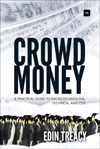Book review: make technical analysis work for you
If you’re a trader, then Crowd Money is a book that you should definitely read, says Matthew Partridge.


by Eoin Treacy
Technical analysis the idea that the past price movements of a share or commodity can be used to predict the future is controversial. Many investors, especially short-term traders, swear by it, and have built careers from using it. Others believe it is nonsense and prefer to look at fundamental factors, such as economic growth. Recently, there has also been an explosion of interest in the impact of emotions and crowds on markets.
Crowd Money: A Practical Guide to Macro Behavioural Technical Analysis, by MoneyWeek contributor Eoin Treacy (who writes this week's cover story on robotics), explains how you can combine all three approaches: technical, psychological and fundamental, to spot opportunities in today's markets.
Subscribe to MoneyWeek
Subscribe to MoneyWeek today and get your first six magazine issues absolutely FREE

Sign up to Money Morning
Don't miss the latest investment and personal finances news, market analysis, plus money-saving tips with our free twice-daily newsletter
Don't miss the latest investment and personal finances news, market analysis, plus money-saving tips with our free twice-daily newsletter
Treacy discusses several technical indicators, but essentially they fall into two main types. The first is the divergence between the current price and the moving average. Most traders like to buy shares that are moving above their moving average. However, Treacy takes the opposite approach, waiting until the gap between the two becomes large, and then betting in the opposite direction, on the assumption that they will re-converge. To support this approach, he points to the evidence that crowds can frequently assume a mob mentality, and succumb to extreme emotions, causing bubbles and panics.
The second type covers price ranges and breakouts, and Treacy's approach here is a little more complicated. On one hand, he looks for emerging price trends, and attempts to buy into them when they appear. However, he emphasises thattrends eventually come to an end, so he also explains whystop-losses are a key component of any traders' armoury, andexplains how exactly to deploy them. Indeed, he pays a lot ofattention to spotting trends that have gone too far, so that hecan then bet on a reversal.
The final chapters, covering around a third of the book, focuson more fundamental factors affecting markets. Unsurprisingly,one of these is monetary policy, which played a big role inthe recovery from the financial crisis, and now threatens todo the opposite as rates gradually return to normal. The riseof emerging economies and the emergence of the globalmiddle class is another trend that looks set to continue. The last chapter of the book looks at 150 stocks that Treacy calls"autonomies" meaning global companies that are set toflourish in the near future.
Combining all three of these topics into a single book isambitious and arguably Treacy might have done better to focuson technical analysis and psychology, and leave discussionof these fundamental trends to a separate book.
However, theexplanations of chart-reading and technical analysis go a longway to making topics that can seem confusing and esotericto the layman relatively simple and accessible. Similarly,the material on psychology and behavioural finance is clear,convincing and persuasive. Even those who are still scepticalabout the value of these approaches will have to admit thatthere is a lot of evidence to back them up. If you're a trader,then this book is something that you should definitely read.
Crowd Money: A Practical Guide to Macro BehaviouralTechnical Analysis by Eoin Treacy, is published byHarriman House (£45).
Matthew graduated from the University of Durham in 2004; he then gained an MSc, followed by a PhD at the London School of Economics.
He has previously written for a wide range of publications, including the Guardian and the Economist, and also helped to run a newsletter on terrorism. He has spent time at Lehman Brothers, Citigroup and the consultancy Lombard Street Research.
Matthew is the author of Superinvestors: Lessons from the greatest investors in history, published by Harriman House, which has been translated into several languages. His second book, Investing Explained: The Accessible Guide to Building an Investment Portfolio, is published by Kogan Page.
As senior writer, he writes the shares and politics & economics pages, as well as weekly Blowing It and Great Frauds in History columns He also writes a fortnightly reviews page and trading tips, as well as regular cover stories and multi-page investment focus features.
Follow Matthew on Twitter: @DrMatthewPartri
-
 Coventry Building Society bids £780m for Co-operative Bank - what could it mean for customers?
Coventry Building Society bids £780m for Co-operative Bank - what could it mean for customers?Coventry Building Society has put in an offer of £780 million to buy Co-operative Bank. When will the potential deal happen and what could it mean for customers?
By Vaishali Varu Published
-
 Review: Three magnificent Beachcomber resorts in Mauritius
Review: Three magnificent Beachcomber resorts in MauritiusMoneyWeek Travel Ruth Emery explores the Indian Ocean island from Beachcomber resorts Shandrani, Trou aux Biches and Paradis
By Ruth Emery Published